
|   |

|   |
 e-mail: sunilkothari1933@gmail.com Roopbandh Festival - Shama Bhate's welcome initiative Photos courtesy: Nadroop November 16, 2020 During the pandemic, senior dancers, choreographers, gurus have been busy exploring the new site of virtual platform to showcase their choreographic works. Of the various ways, celebrated Kathak guru/choreographer Shama Bhate of Nadroop institution, Pune, presented her latest choreographic works online on 7th and 8th November 2020 in Roopbandh Festival. Rhythm Labyrinth On 7th November, Nadroop presented Rhythm Labyrinth. In the nritta section was explorations of Pancham Savari tala of 15 beats. Its seeds were sown nearly four decades ago, and I had seen a performance at NCPA of the same nritta section. Shama Bhate in the new visual medium with help of technical team of cameramen Pradyumn Pathak, Pranav Pathak, editing by Pratik Parkhi and Apurva Sathe, sound by Prashant Urunkar, light design by Gunavardhan Soman of SGA Lights, video direction by Apurva Sathe, and participating dancers Ameera Patankar, Avani Gadre, Shivani Karmarkar and Bhargavi Sardesai, has pulled off a hat trick. 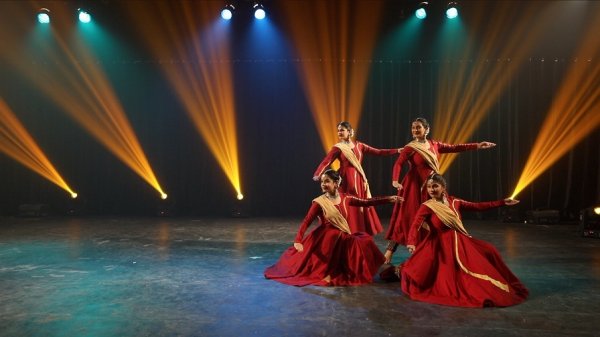 Credits include concept and choreography by Shama Bhate, assistant direction by Parth Patankar; musicians include tabla by Charudatta Phadke, harmonium by Narendra Bhide, vocals by Vinay Ramdasan, flute by Sandeep Kulkarni, sarangi by Sandeep Mishra, padhant recitation of mnemonic syllables by chorus Nadroop troupe. Since it was filmed, there were several advantages for cameramen to take close ups, medium and long shots of various angles of the dancers, four of them in a diagonal line, at times showing four of them on horizontal plane, background with streaming of orange light, four of the streams forming excellent backdrop and visually quite engaging. Shama Bhate with her four disciples has choreographed this work where she has used musical interlude for a long duration when changes were to take place. Instead of having percussionist playing tabla for interlude, she arranged music interlude which was a bit too long, or appeared so because of the medium, but the interesting part was that when dance was shown the music was in Darbari raga and nagma, lehara was in Adana. This was a clever input. During Pancham Savari, Shama Bhate also included 'bandishes' of Mohanrao Kallianpurkar, tode, tukde, bols, padhant recitation all parts of traditional Kathak. The patterns in Rhythmic Labyrinth were fascinating. The interesting part was to have renowned solo Kathak exponent Dheerendra Tiwari as moderator in the Q & A segment. Why Labyrinth? Shama Bhate explained that the beats are universal - our heart beats and cosmic beats. The challenges were of exploring them and it helped her to create a form like labyrinth where you can get lost and also come out with an opening. Also, earlier she was teaching students in a class room and they were preparing for solos. From there they moved to choreography. And since the audience for this virtual platform was able to view cinematically from various angles, the choreography was to be made accordingly. The questions to cameramen and dancers involved in the productions, led to the challenges they all were facing and working artistically to make it an aesthetic presentation. The person from theatre who assisted also said that in theatre, content is 'ashraymukta' and can be improvised, but recorded nritta is 'ashrayabandh' and has to be filmed as performed. Questions to Charudatta Phadke for music accompaniment for tabla and tala elicited his earlier memories of Shama Bhate's creations of 7 and half matra tala, and also how they were treated as 5 and two plus half making 7 and half and divisions of two and half three times making 7 and half. For instance when Gat is performed, how would the accompanist manage using few bols, and so on. The dancers said that during lockdown they had to rehearse and imagine how audience would watch them dancing through the lens. Shama Bhate explained that exchange of energies was focused upon. 15 matras became a perfect opportunity to bring together feeling of space, time and joy. Now the idea was love for dancing and not for audience because the audience was not in front of them. One dancer said that she was conscious that the audience for camera was there. 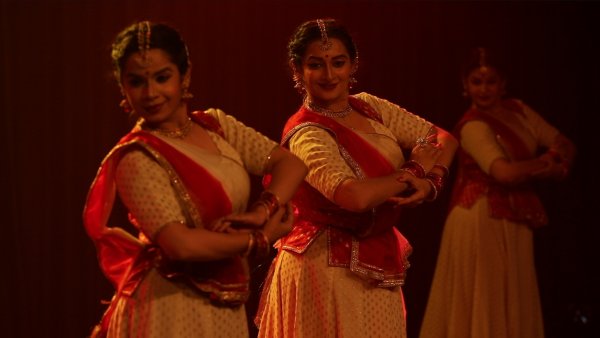 The four of them had excellent chemistry between them. The 'shabashi' of Gurujan as 'kya baat hai' was not here but as a team of Nadroop they felt the atmosphere was warm. Shivani Karmarkar said that she felt that the mood of 'mehfil' was built up, not because there was a crowd of thousand, but few of them who were known to each other, that was what they were enjoying. For Ameera Patankar, there was less scope for self expression in this work, but since one had practiced a lot for it, the line of self expression had got blurred. Performing a solo tukda there could have been self expression but it had to take a back seat. In tatkar, the foot work was not fixed. There were 25 possibilities by taking 5 avartanas. Dancers resorted to beautification as in the end the 'tihai' was fixed. Dheerendra Tiwari asked Shama Bhate how she decided with space, time and speed as camera was another element in this production. She said she left it to cameraman Apurva Sathe. He designed it to look at it as a spectator would. He felt that this was something new that he was learning in his trade! Shama Bhate recalled how she had incorporated 'bandish' of Kedar raga to Rohini Bhate's 'lamchhad' kavit, long kavit. It had to synchronize with the long kavit and its 'chhanda' and laya. The problem in 15 matras was that there was no variation of laya .The tode and tukde had to be shown in one laya. The question of divisions of senior and junior dancers was obliterated. All were treated as equal and the group had to be projected as one. Since technical knowledge is difficult to express in language, often the replies by dancers looked similar as all were faced with common challenges. Shama Bhate concluded that they all shared one philosophy that aesthetics had to be achieved. So there were no seniors and juniors and the production gave them satisfaction as they all had worked very hard to see this work became a reality. Bhakti Gatha On 8th November, Nadroop presented Bhakti Gatha of four different devotees. Narahari Sonar from Maharashtra, from West Bengal a story of a young man who wanted his mother's corpse to be cremated in a cemetery, from South a hunter Kannappa worshiping Lord Shiva's lingam in the forest offers his eye when his devotion is tested and receives 'mukti' as sage Kannappa, and from Rajasthan as Kathak dancer Hiralal, how he learns Kathak from his guru after several trials and tribulations. 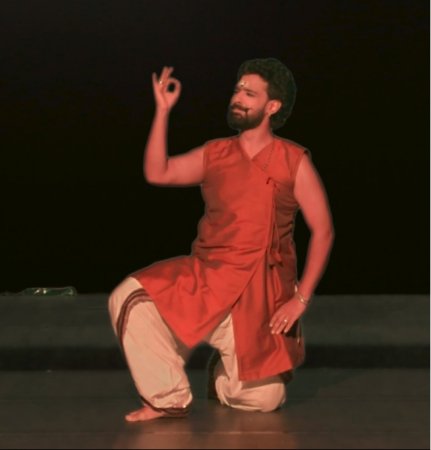 Nikhil Ravi Parmar as Narahari Sonar Narahari Sonar from Pandharpur is a goldsmith and a staunch devotee of Lord Shiva. He does not worship anyone else. When he is asked to step into the temple of Vithal Rukumai and have darshan, he refuses. He is asked to take measurement of statue of Vithal; he reluctantly does so and gets darshan of Vithal. From then on he becomes a devotee of Vithal. The story dwells on how god makes his devotee see him as one God, be it Lord Shiva or Vithal. Narahari sings 'Pandhari maharaj ki jai', and dances singing Vithal, Vithal, Vithal, Vithal. The dancer Nikhil Ravi Parmar, disciple of Shama Bhate, has studied at Lalit Kala Kendra, and also trained at Maya Rao's institute and with Maya Rao's daughter Madhu Nataraj, in Bangalore. With mukhabhinaya, silent mime, he offers flowers to the image of Lord Shiva, and later on covers Vithal's image with gold even reciting 'Om Namah Shivaya'. There is a slide projection of Pandharpur temple, singing of Varkari sampradaya, also projection of the golden disc. As per his wishes, Narahari is taken to the temple blindfolded; he opens his eyes, wipes his tears when he sees the image of Vithal and starts singing Vithal, Vithal, Om Namah Shivaya. Often the cameraman has taken long shots and created ambience of Maharashtra, enhanced by Varkari music and repetition of name of Lord Vithal danced in ecstasy by Narahari Sonar.  Avinav Mukherjee as Bhamakepa Disciple of Guru Geetanjali Lal, Kathak dancer Avinav Mukherjee plays the role of a young man whose mother is dead and her corpse has to be cremated. No one helps him; instead people beat him up. He worships goddess Kali, applies ash on his body, recites mantra in cremation ground, swims across the river to go to the opposite bank taking his mother's corpse and finally performs 'Agnidaha', placing it on the funeral pyre. The projection of image of goddess Kali with her large eyes, red tongue, when the young man dances with his hair undone shows how the goddess has severed heads of demons and made a garland of skulls, 'mundmala.' He gets up and is in a trance, then collects firewood, sets fire to it and places the corpse on it, chanting mantras. In the end he offers prayers to goddess Kali falling at her feet. 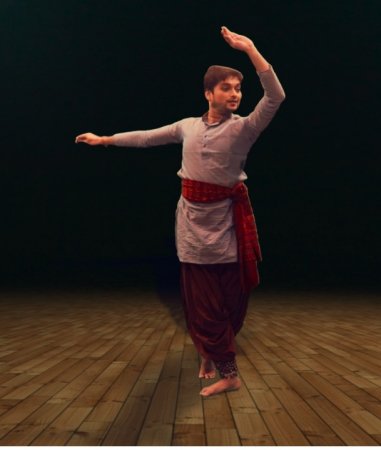 Souvik Chakraborty as Hiralal Souvik Chakraborty, a disciple of Guru Vijay Shankar, has studied under Birju Maharaj in workshops, with Kumudini Lakhia, and is a versatile dancer. The story is of a young man Hiralal from Rajasthan, where there is a parampara of Kathak in royal court. He wants to learn Kathak. He studies Kathak under a guru, doing guru seva, against all odds. After nearly 60 years there is a celebration by the Maharaja of Jaipur, and Hiralal is invited. He attends the celebrations and goes to see his guru, falls at his feet; there is now no distinction between the shishya and the mentor. He seeks 'sadgati', the release, 'moksha' at the feet of the guru. The piece begins with notes of sarangi, the most important instrument used in Kathak dance which evokes Rajasthani atmosphere. There is a projection of palace of Jaipur and Govindaji's temple. Hiralal dances using Gat, palata, bows to his guru, washes his feet, offers tilak, and a shawl. In flashback, he remembers how people used to beat him. But he overcomes all this and finally sees his guru and bows to him. 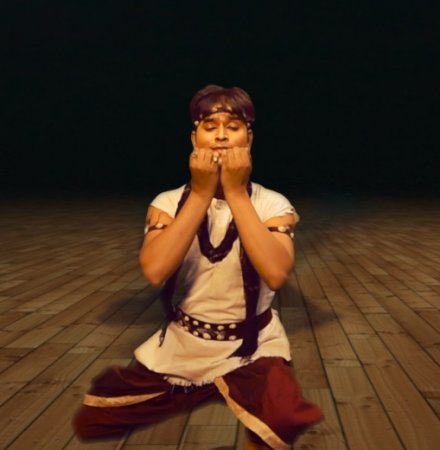 Vishavdeep Sharma as Kannappa The fourth story of sage Kannappa was presented by Vishavdeep Sharma, who is trained in Kathak by Narendra Prasad, Nandini Singh and Prerana Shrimali. Nearly 1500 years ago there were devotees known as 'Nayanaar.' Kannappa belonged to that group, even though he was a hunter and in the forest he offers the flesh of hunted animals to the Shivaling. The priest watches and says that he should not offer the meat of hunted animals to Lord Shiva. But Lord Shiva tells the priest that Kannappa is a true devotee. To test his devotion Lord Shiva shows that from the eyes of the lingam, one eye is blinded and oozing blood. Kannappa takes his eye and places it on Shiva's lingam. Seeing this, the priest is taken aback and believes him to be a true devotee of Lord Shiva. He asks him to take bath, take flowers and offer to Lord Shiva. Since he offers his eye meaning 'Kann', he is known as Kannappa. He sings the praise of Shiva 'Hara Hara Mahadeva'. There is excellent projection of sculpture of Lord Shiva in forest. Also to establish Kannappa as hunter, the projection of the forest is made and sounds of birds and animals enhance the atmosphere. After the four presentations, the compere Vidula Hemant asked them questions about their experience performing for the digital platform. The pieces were explained to each dancer by Shama Bhate. The dancers had under her suggestions choreographed their own movements to narrate the story. The video recordings were exchanged and some movements were explained to be performed in particular manner. It was quite tough as each dancer was in a different city, except Nikhil Ravi Parmar. Paramar said that he liked to work with Shama Bhate and explore various mediums. In lockdown he got this opportunity and was keen to learn how to dance for this medium. Of course like all other dancers he confessed that he would like to perform live before an audience. But this experience was also important for the present times. Souvik Chakraborty responded that in traditional Kathak instead of mere 'chhed- chhad' and Krishna-Radha content, he likes to work with other gurus and different content. Also other rasas need to be brought in. In the role of Hiralal, he could explore different rasas, joy, frustration, rejection, Hiralal's desire to learn Kathak and feelings of devotion. He believes that several experiments need to be done in choreographing Kathak. Vishavdeep Sharma did not know anything about Kannappa or his story and that gave him scope for exploring the character. Shama Bhate explained the story to him so he developed the atmosphere of forest, birds, animals and further discussions helped him to create the character. Avinav Mukherjee said that he had known of 'Bhamakepa' in West Bengal, though there is more knowledge about Ramakrishna, and he is a popular figure. But Tantra is also known for 'sadhakas' and the story offered scope for other rasas like raudra, bhaya, vatsalya of the goddess. He said that in a live performance, within 8 to 10 minutes one can bring climax because of the presence of a live audience. This presentation seemed to him like a short film. Nikhil Ravi Parmar went from Pune to Pandharpur to get the feel of Varkari singing, devotees, and atmosphere of Pandharpur. He learnt about devotees carrying palanquin, singing songs while going on Yatra, learnt about Dhyaneswara, and became aware of the region. Ameera Patankar and others helped Shama Bhate to assist the dancers by long distance when necessary. The musician Narendra Bhide admitted that it was a learning process as he had to create regional music for each story. All participants felt that they had learnt new things and were ready for a new digital age. Lockdown has to be taken as a positive state as it helped them to defeat the depression of Corona, and all thanked Shama Bhate and Nadroop for this particular initiative that helped them beat the blues of the Corona pandemic. Compere Vidula Hemant revealed that Shama Bhate wanted only male dancers for Bhakti Gatha because she felt that the narrative changes with male dancers, and Kathak need not be performed only by female dancers. The tradition admits of both male and female dancers. 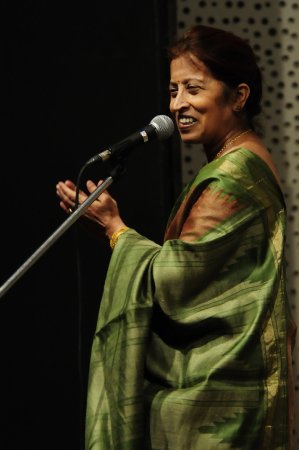 Shama Bhate Being seasoned dancers, all the artistes performed well, and did justice to the roles assigned to them. The musicians rose to the occasion contributing their might to the productions. The camera work, sound etc., being professional, both the productions has admirable finish. Shama Bhate's vision during pandemic to find an alternative for staging dance on digital platform was well conceived, giving hope that this new digital medium will help the spectators, Kathak gurus, choreographers, dancers, accompanying musicians to keep their interest alive in traditional Kathak dance and innovative presentation. While discussing about the creative process, Bhate admitted that this work was done entirely on her own resources without any financial grant. But she was determined to go through the process and the project. This raises issues of finance. Like some organizers, dancers are ticketing their programs; Bhate too would have to offer the programs for a moderate fee.  Dr. Sunil Kothari is a dance historian, scholar, author and critic, Padma Shri awardee and fellow, Sangeet Natak Akademi. Dance Critics' Association, New York, has honoured him with Lifetime Achievement award. Post your comments Please provide your name and email id when you use the Anonymous / blog profile to post a comment. All appropriate comments posted with name and email id in the blog will also be featured in the site. |